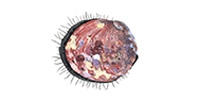Thank you for visiting the Seafood Selector. EDF is planning a new approach to providing information to consumers about good seafood choices. Please come back soon for updates.
Abalone

Red Abalone, © Amadeo Bachar
Recommended servings per month
| Contaminant | Men | Women | Kids 6-12 | Kids 0-5 | |
|---|---|---|---|---|---|
| Abalone (farmed - closed containment) | Mercury | 4+ | 4+ | 4+ | 4+ |
| Abalone (farmed - sea ranching) | Mercury | 4+ | 4+ | 4+ | 4+ |
Eco details:
- Abalone are sessile (growing in one spot) and thus are vulnerable to over exploitation. Populations of at least five abalone species on the U.S. Pacific coast have been depleted.
- In contrast, farming abalone is relatively environmentally benign.
- However in China and Japan, some abalone are raised in "sea ranches" that are, in essence, underwater pastures for farmed abalone to graze. Large areas of seafloor are modified for farming purposes, resulting in significant changes to the habitat. Potential predators and other grazing species are removed, and widespread control over the types of animals and plants found within the ranched area is maintained. These sources of abalone are considered an Eco-Worst and should be avoided if possible.




